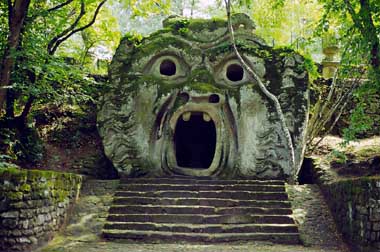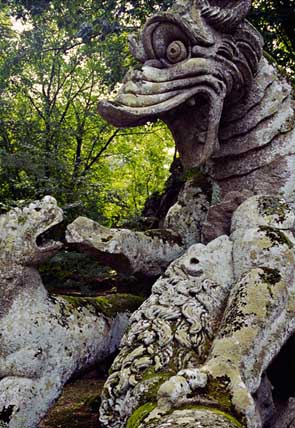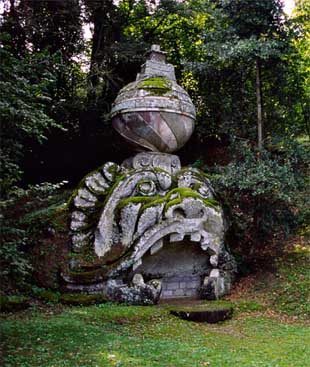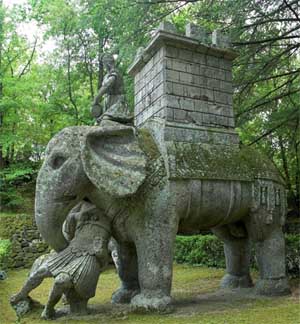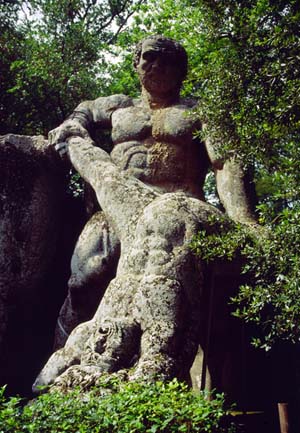pop up description layer
HOME
Cryptozoology UFO Mysteries Aviation Space & Time Dinosaurs Geology Archaeology Exploration 7 Wonders Surprising Science Troubled History Library Laboratory Attic Theater Store Index/Site Map Cyclorama
Search the Site: |
|
Bomarzo: Grove of the Monsters
Antonio edged his way through the bushes. He wasn't scared, he told himself. He was ten now. Almost a man. The other boys were just trying to frighten him with their stories of monsters hidden in these woods. There was really nothing here. He had to admit to himself that the place was spooky. It looked like it might have been a garden in times past, but it hadn't been taken care of in decades, maybe even centuries. Even so, there was nothing to be afraid of. This was 1905. Twentieth century Italy. Nobody believed in monsters anymore. Suddenly Antonio found himself standing in front of an enormous shape. At first he thought it was a rock, but the lines were too regular. He stepped back a bit and then saw it. An eye glaring at him. Suddenly he realized that he was staring at the face of a huge dragon, its jaws open and ready to devour him. Antonio turned and ran and ran and ran. He was out of the grove in less than a minute, never to return. Gardens come in many varieties. Some are minimalist like the famous Zen garden at the Ryoan-ji temple in Kayoto, Japan. The garden consists of only an area of raked sand punctuated by 15 irregularly-shaped rocks of varying sizes. Others have fantastically intricate designs, like the French formal gardens at the Palace of Versailles in France. They contain several square kilometers of stunning flower beds, terraces, fountains, canals, topiary and statuary.
Perhaps the weirdest garden, however, is located just outside the small village of Bomarzo, in Italy. It contains some of the most horrific statuary that one can imagine. A huge elephant carries a trampled soldier, a giant tears apart his enemy, a dragon combats its prey and a colossal mouth gapes open to swallow visitors. Who would have made such a bizarre place and why? The Melancholy Duke The story starts with a young nobleman named Duke Pierfrancesco "Vicino" Orsini. Orsini was born around 1516 and married a noblewoman named Guilia Farnese in 1544. He worked as a military officer and diplomat until 1553 when he was captured in the same battle that killed his best friend. He was held for ransom for three years and then, shortly after his release, his beloved wife died. Depressed, Orsini retreated to his family's holdings near Bomarzo where he began to plan his strange, melancholy garden. What is known of the garden is mostly just what historians have found by visiting it. Orsini left no records telling what his intentions were in creating the peculiar grove filled with macabre statuary. Fortunately, Orsini placed inscriptions near many of the objects, giving us some clue to what he was thinking. Upon entering what Orsini called his Bosco Sacro ("Sacred Grove") visitors are greeted with the message: TU CH'ENTRI QUI CON MENTE PARTE A PARTE ET DIMMI POI SE TANTE MARAVIGLIE SIEN FATTE PER INGANNO O PUR PER ARTE. This challenge to visitors translates as "You who enter this place, observe it piece by piece and tell me afterwards whether so many marvels were created for deception or purely for art." The grove was laid out on a hill and the statues carved out of natural, volcanic, rock outcroppings. For this reason there seems little order to how the place is organized. This, however, might have also been a part of Orsini's plan. With no logical layout, as one of the inscriptions say, it might have been his way "just to set the heart free."
There are more than two dozen major works of immense art in the garden including a dragon fighting with lions and wolves, many figures depicting the Roman/Greek gods,and a house purposely built on an angle to throw visitors off balance. The style is referred to as Mannerist, a genre popular in the late 14th century in which artists sought not to please viewers, but to astonish them by using figures with elongated forms in exaggerated and out-of-balance poses. The artist who created the scupltures is thought to be Pirro Ligorio, a well-known architect of the time. While guests might be so overwhelmed by Ligorio's statues that they might be tempted not look carefully at every object in the grove, there are several of the scuptor's works here that definately should not be missed. Elephants, Giants and Dragons One of the largest and most striking pieces of art is the War Elephant. This immense creature carries a castle on its back and an unconcious Roman soldier in its trunk. While elephants carrying castles were a popular symbol in Medieval and Renaissance art, this particular packaderm might be a reference to the invasion of Italy by Hannibal in 218 BC. If so, Hannibal's unique use of elephants in that war to strike terror into the opposing army is forever frozen in stone at Bomarzo. Other experts, however, insist that the elephant is a reference to the story of Eleazar in The Book of Maccabees. Eleazer kills the king's elephant, but is in turn himself killed when he is crushed under the beast. Another striking work of art captures two giants in battle. One has gotten the better of the other and is engaged in ripping him in two by the legs. Here the nearby inscription gives a clue as to what is going on: If Rhodes previously took pride from its Colossus so by this one my wood is glorified and further I can do no more than I have done. This sounds like a quote from Arioto's poem Orlando Furioso. In that work the hero, Orlando, is driven mad by the loss of his love, Angelica. In his insanity he happens across a woodsman who he kills by the same method as depicted in the statuary. Some scholars suggest this is a hint from Orsini, like Orlando, he is being driven mad by the loss of his wife, Guilia. Another enigmatic work at Bomarzo is what appears to be the head of a marine monster with a sphere balanced on the top of its skull. The sphere itself is topped with a castle. The official guide to Bomarzo lists this as Proteus and/or Glaucus, who were early sea gods. Other scholars refer to this as the "mask of madness." Like most of the art work at the sacred grove, the exact meaning has been lost.
Perhaps the most terrifying effigy at the sacred grove and the image most associated with the garden is a horrific inhuman face carved into the rock of the hillside. The mouth, opened wide in a scream, is big enough to walk through and the inscription "all reason departs" accompanies this work. Some scholars identify the creature as an Orc ready to swallow unwary children. Others think Orsini meant it to be the mouth of hell. Perhaps it is both. In any case, Orsini retained at least some humor in the creature's portrayal: There is enough room inside the head for visitors to have a picnic lunch seated at a table formed by the figure's tongue. Orsini died in 1584 and after that nothing more was added to the garden. By the 19th century the sacred grove lay forgotten and overgrown. Stories developed among the towns people about the monsters in the haunted woods and many villagers were frightened to go near the area. Eventually the place was dubbed "The Grove of the Monsters." 20th Century Visitors In 1938 the Spanish surrealist artist Salvador Dali paid the grove a visit. Making his way through the tangle of weeds he was awestruck by the figures. He shot a short film at the park and later the figures were to inspire his 1946 painting The Temptation of Saint Anthony. Other artists soon echoed Dali's interests. The poet Andre Pieyre de Mandiagues wrote as essay about the garden. Artist Niki de Saint Phalle was inspired by it to create her own Tarot Garden in Tuscany, Italy after she visited Bomarzo. In 1962 Argentinian writer Manuel Mujica Láinez wrote a novel entitled Bomarzo, based on the life of Orsini. He followed the novel by composing an a libretto based on the book and in 1967 Alberto Ginastera set the libretto to music and it became an opera for which Mujica Láinez and Ginastera shared a Pulitzer Prize. It was not until the 1950's when the park was bought by Giovanni Bettini that some restoration began to take place. Located 60 miles north of Rome, it is now open to the public and attracts artists and art lovers from all over the world.
Self Therapy? Why did Orsini build the strange garden? There are several theories historians have come up with. One possibility is that he wanted to create a contrast to the symmetry of the Renaissance gardens of his friend Cristoforo Madruzzo. Orsini knew he couldn't afford to compete with Madruzzo on the size or splendor of the garden, so instead he tried to create a place that would shock and awe his visitors. Another theory, suggested by author Christopher McIntosh, is that making this melancholy garden was a form of self-therapy for Orsini to get him out of his depression after the loss of his wife. McIntosh likens it to a person who is depressed and finds that reading gloomy poetry creates a counter-reaction that cheers him up. Did this work for Orsini? One can only hope so. The last item added to the garden was not a giant monster, but a small temple. It was built twenty years after the rest of the garden and was dedicated to Orsini's second wife. Perhaps in this final creation we see some sign that the Duke found rest from the monsters which seemed to haunt his soul. A Partial Bibliography Gardens of the Gods, by Christopher McIntosh, I.B Tauris, 2005 The Sacred Grove of Bomarzo, by John-Paul Stonard, Art andArchitecture, http://www.artandarchitecture.org.uk/insight/stonard_bomarzo.html Bomarzo:Grove of the Monsters, http://www.bomarzo.net/index_en.html Copyright Lee Krystek 2007. All Rights Reserved. |
|
Related Links |
|
|



